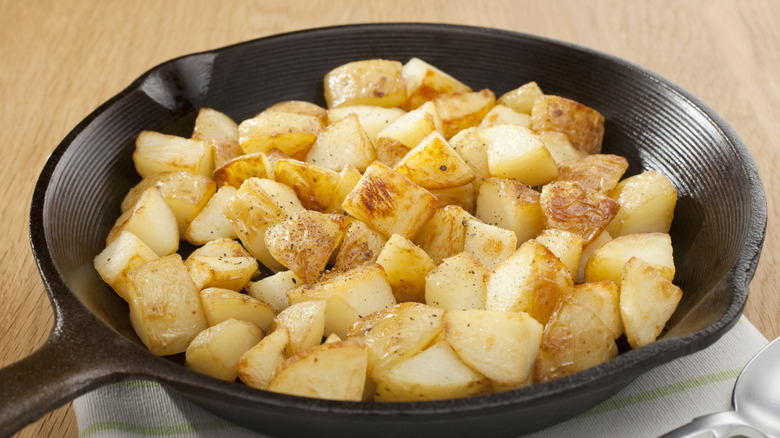The Best (And Worst) Potatoes For Crispy, Comforting Home Fries
Home fries, fried potatoes, breakfast potatoes– whatever you call them, you've probably had a side order of potatoes with your bacon and eggs at least once in your life. Home fries, just in case you've never heard of them, are those little cubes of potato that have been tossed in a pan and fried up in butter until crispy and golden on the outside and soft and creamy on the inside (not unlike your average French fry).
Much like other popular breakfast items, like eggs, toast, or pancakes, home fries sound incredibly, almost unassumingly simple on paper. Just cut some potatoes into cubes or chunks, fry them up in a pan, and then serve with salt, pepper, and ketchup. But you can't get to that perfect combination of crispy exterior and smooth interior without having to make a few mistakes. If you don't parboil your potato cubes, for example, you'll wind up with tough, almost raw home fries that taste both bland and undercooked. You may also find that lightly "smashing" your potatoes may help get a crispier exterior, as smashing the potatoes slightly means there's more surface area being exposed to the heat. Making home fries requires a careful combination of heat and seasonings to get potatoes that are both crispy and soft all at once.
Of course, you can't just use any potato for your morning home fries. You must first look for a very specific type of potato — one that has a very high starch content.
The Russet potato is a very good choice for making home fries
You may have seen recipes that call for a particular type of potato, such as a mashed potato recipe that calls for Yukon Golds or a roast chicken recipe that says you'll need little red or fingerling potatoes. This is because all potatoes, while sharing similar traits and characteristics here and there, actually differ in their starch content.
But what does starch have to do with home fries? Starch is what gives potatoes their soft texture, at the cost of making them high in carbohydrates, While some people may remove the starch from their potatoes before preparing them in certain dishes, starches can absorb liquids, thus leading to a crispier end-product. One such potato that is famously high in starch is the Russet variety, although Yukon and Idaho potatoes are very high in starch as well.
It is this high level of starch in Russets, Yukons, and Idaho potatoes that makes them good for home fries. They can not only absorb the butter, but they will also have a very soft, creamy inside without compromising too much on the crispy and golden exterior. The only drawback, however, is that cooking a high-starch potato for too long can lead to it getting "crumbly," but this won't have any effect on your flavor in the end.
If Russets and other high-starch potatoes are the best for home fries, then what would be the "worst" potatoes?
Waxy potatoes aren't very good for home fries
If you've ever eaten one of those little red potatoes, you'd notice they have a smooth and creamy texture, often referred to as "waxy." While these potatoes are good for roasting or boiling, they don't excel in making fried potatoes. Why is that?
Unlike the earlier varieties of Russet, Idaho, and Yukon potatoes, waxy potatoes like New, fingerlings, and Red Bliss are lower in starch content, instead being high in moisture. These potatoes don't absorb moisture as well as high-starch potatoes do, giving them more structure when exposed to liquids or heat. If you were to take a bowl of cubed Russets and a bowl of cubed Red Bliss potatoes and throw them into separate skillets, you'd notice that the Russets seem to break down somewhat. While you could pierce the Russet cubes easily with a fork to the point you could mash them if you want, those Red Bliss cubes won't break down as easily, instead holding their shape and texture even after all that time. You'll get the soft, creamy interior and crispy exterior of home fries with Russets, but you'll still have that solid, waxy texture with Red Blisses.
It's that high level of starch that makes smaller potatoes good for things like roast dinners or boiling, while starchy potatoes can give you the creamy interior you expect to find in French fries, hash browns, and home fries.


